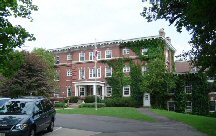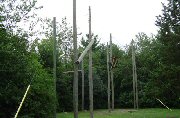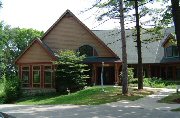| From Strugglingteens.com Visit Reports Oconomowoc, Wisconsin Visit by Lon Woodbury, August 3, 2004
At first glance, Rogers Memorial looks like a college campus. Located on 50 acres, the buildings, ropes courses, walkways and even a dock on an adjacent lake are scattered throughout this rural property. This natural setting allows residents to enjoy and benefit from the beauty of their environment. Even though they are surrounded by rural homes and developments, the initial impression is of a secluded facility designed for healing. The main building is a traditional style brick building with flourishing ivy climbing the outside walls, similar to many college campuses. Rogers has several other buildings that range from older two-story buildings to newer ones any homeowner would be proud to have on their property. The two-story buildings have a box like outside appearance, but are very functional and pleasing inside. The outside of these older buildings are currently being remodeled and upgraded to meet the standards of the buildings on the rest of the campus.
The main building houses the administrative offices and the general Child and Adolescent treatment center with an extensive ropes course located just down the hill. There are three different groupings of exercises including both low and high ropes. With a sense of obligation to the community, Rogers Memorial encourages local youth and adult groups to take advantage of this particular part of their facility. Some of the outside youth groups were using the courses while I was visiting. Over the past 97 years, Rogers Memorial Hospital has provided a wide array of clinical services for adults and children in both outpatient and residential treatment. My visit focused mainly on the Child & Adolescent Center. Developed to provide services for a wide array of conditions, the Center is especially strong on treating obsessive-compulsive disorders. There are three full-time child and adolescent psychiatrists on staff, and the adventure-based program is an important part of the Center, as well as regular use of the lake and dock.
The Eating Disorder Center is located in an adjacent building. Although the residents here are mainly female, the Center is unique in that they also work with males with eating disorders. The Eating Disorder Center focuses on four primary elements. First is nutritional education. The second element is to develop cognitive-behavioral skills through group and individual therapy and experiential education such as the ropes course. The third is to develop a positive sense of self through art therapy, psychodrama, healthy exercise and experiential activities such as their ropes courses. Finally, the fourth is to help each resident identify their personal obstacles, which might come from abuse, trauma or other causes. The main focus at the Center is group therapy, but individual therapy is also a regular part of their day. Both approaches are strongly flavored with the Center's emphasis on Cognitive Behavioral therapy, which is designed to help the residents deal with ritual prevention and to identify and correct errors in thinking. As I toured the building and experienced the pleasing surroundings, most of the residents were busy with various activities and their behaviors seemed to indicate they felt emotionally safe. However, I saw one group of students lined up in the cafeteria of the Eating Disorders Center, and it struck me that there was a large amount of anxiety radiating from the group. I asked the staff member who was giving me the tour about my sense of a "lack of safety," and they explained that this group was lining up for snacks. That made sense. In an Eating Disorder Center, the anxiety that brought them to the program in the first place was the issue of food. What I saw first hand was their struggle with the root of their problems, how to deal with food! The inside of all of the buildings emphasized soft tones with pleasing paintings on the walls. The effect is soothing. That, combined with the natural setting of the outside grounds, creates a sense of emotional safety that would facilitate healing. The goal is to humanize the treatment as much as possible. The appearance and emphasis at Rogers has moved so far away from the stereotypical image of a hospital as an institution, that I asked the administration why they still used the term "hospital." They said that exact question was being discussed internally. An important component is their work with the family. The Center invites the entire family for family work on a weekly basis when feasible. If the family lives too far away to visit weekly, the work is done on the phone. Traditionally, Rogers provided service to the local area including Milwaukee, which is not too far away. Today, they still serve their home base, but are now marketing nationally. They feel they offer a quality service that can compete very well on a national level, especially in treating obsessive-compulsive, depression and anxiety disorders, eating disorders, chemical dependency, and child and adolescent concerns. © Copyright 2012 by Woodbury Reports, Inc. |


